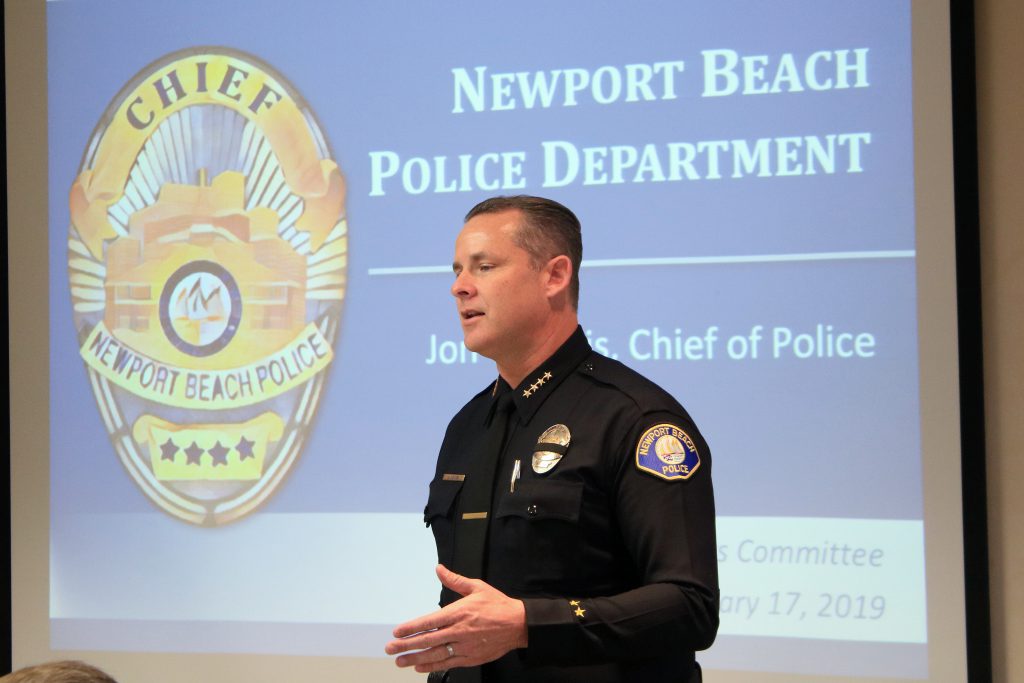
— Photo by Sara Hall ©
Crime statistics, strategies and trends were the focus of an early morning meeting this week with the top police officer in the city.
Newport Beach Police Department Chief Jon Lewis gave a presentation to a group of about two dozen community business leaders and city and district representatives at the Newport Beach Chamber of Commerce Government Affairs meeting on Thursday.
Lewis talked about two issues that have been the focus of several recent community discussions: Homelessness and residential burglaries.
“We play a role in homelessness,” as a police department, Lewis said, but it’s going to take a lot of people and groups working together to find a solution. “It’s a problem that we can’t simply arrest our way out of.”
It’s a vulnerable population, he added. Some have mental health issues, or drug or alcohol problems, or other risk factors.
“They’re not going to get better while they’re living on the street,” Lewis said. They need a healthy and safe environment with the right resources, he added.
Newport Beach Police Department has a dedicated officer, Tony Yim, that works with the homeless population, as well as with regional organizations, in an effort to find long term solutions.
It takes creative solutions, collaborations, but also enforcement, Lewis noted.
The police chief also warned the group about organized home burglary crews that have popped up. Some don’t “case” the homes prior to breaking in, but have been a bit more brazen with their crime. They ring the doorbell or knock to see if anyone is home, and if they find it empty, they simply break a window and gain access into the home.
“They’re in and out of the house within a couple of minutes,” Lewis said.
Residential burglaries in Newport Beach trended up slightly in 2018, Lewis noted, but they’ve made some pretty big cases that he thinks will impact that number. It’s not specific to Newport, these are regional crime trends, he added.
“We can’t take our foot off the gas when it comes to that kind of stuff,” Lewis said.
They have to be fast, collaborative, and accountable for these types of incidents as they occur, he added.
When talking about police work, a lot of it boils down to response time, Lewis commented.
“What matters is how quickly we answer the phone and how quickly can we get there,” Lewis said.
On average, it takes three minutes and 11 seconds to respond to priority one (urgent/emergency/life threatening) calls. That time starts when the dispatcher receives the call and completes when an officer arrives on the scene.
“In terms of our industry, this is smoking fast,” Lewis said, compared to others that might average five, seven or even 10 minutes.
They are consistently around the 3:11 mark, he added. Priority two calls (major property loss or damage risk, but not life threatening) average about five minutes and 41 seconds.
Another statistic he’s proud of are the ring times. About 98.6 percent of the time, 911 calls are answered within three rings, or about 10 seconds, in Newport Beach. The state measures the time within 15 seconds, but NBPD takes it a step further, Lewis commented.
“Like everything else we do, I think we’re a cut above,” and hold themselves to a higher standard, Lewis said.
In terms of volume, NBPD reported 101,311 Computer Aided Dispatch events last year, or about 277 per day.
“A lot more than people would think,” Lewis said. “There’s a lot of stuff going on in this town.”
They book about 3,500 people every year, or roughly 10 people per day, which surprises some people, he added.
Lewis leads a department of 258 paid employees and 53 volunteers (including the explorers). It’s good-sized, he noted.
The 10th chief in the department’s history, Lewis started in the NBPD in the early 1990s and worked his way up, taking over the top spot in March 2016.
“It’s an unbelievable opportunity,” Lewis said. “Every day I pinch myself.”
Lewis explained that of the paid positions, 147 are sworn officers and 84 civilians. Using civilians is a relatively new practice, he noted. Several years ago, they noticed that not all jobs necessarily needed a sworn officer, things like taking fingerprints or administration could be done by civilians.
The bottom line is the work all the employees do and the performance of the department overall, he said, and that’s what the statistics show.
Lewis also spoke about some legislative updates (AB 748 and SB 1421), crime strategies, recruiting, succession planning, cold case investigations, traffic safety, capital improvements, and more.
For more information, visit nbpd.org and newportbeach.com.




